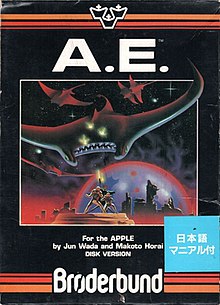| A.E. | |
|---|---|
 | |
| Developer(s) | Programmers-3 |
| Publisher(s) | Broderbund |
| Designer(s) | Jun Wada Makoto Horai |
| Platform(s) | Apple II, Atari 8-bit, VIC-20, MSX |
| Release | 1982: Apple, Atari 1983: VIC-20 1984: MSX |
| Genre(s) | Fixed shooter |
| Mode(s) | Single-player |
A.E. (sometimes shown unpunctuated as AE) is a fixed shooter written by Jun Wada and Makoto Horai for the Apple II and Atari 8-bit computers and published by Broderbund in 1982. Versions followed for the VIC-20 (1983) and MSX (1984). Unlike most earlier shooters which have a solid color or starfield as a background, the action in A.E. takes place in front of science fiction scenes. Attacking creatures emerge from points in the image, often appearing to come from behind objects. Combined with a slight scaling as they advance, there is the impression of depth.
According to the back of the box, "A.E. is the Japanese word for 'ray' as in Manta Ray or Sting Ray", robotic versions of which are enemies in the game.
Gameplay
The player's ship can be moved left and right along the bottom of the screen. The fire button launches a missile upward which detonates when the button is released.
Development
Broderbund partnered with Japanese developer Programmers-3 for several games, and A.E. was the first of these. According to Broderbund co-founder Doug Carlston, the Atari 8-bit version of A.E. was the first Atari computer game written in Japan.
Reception
Arnie Katz wrote for Arcade Express: "The swirling flightpaths of the attackers as they zoom hither and yon around the eight playscreens is the principal feature that distinguishes 'A.E.' from the usual run of invasion games." He pointed out that the images the game is played over have little bearing on gameplay. Citing a satisfying difficulty balance, Katz concluded with a score of 8/10.
InfoWorld's Essential Guide to Atari Computers cited it as "another winner" for Broderbund. Computer Games magazine gave the Atari and Apple versions an "A" in its "1985 Software Buyers Guide." Writing for Videogaming and Computer Gaming Illustrated, Susan Levitan concluded: "A.E. is a highly recommended, very challenging and rewarding game. The 3-D graphics are stunning and the serpentine movement of the A.E. is mesmerizing."
References
- Hague, James. "The Giant List of Classic Game Programmers".
- "A.E. back of box". Atari Mania.
- ^ "1985 Software Buyers Guide". Computer Games. 3 (5). US: Carnegie Publications: 12. February 1985.
- Barry, David (October 1983). "Profiles: The Carlston Trio". Antic. 2 (7).
- Katz, Arnie (April 10, 1983). "The Hotseat: A.E." Arcade Express. 1 (18): 7.
- Mace, Scott (1984). InfoWorld's Essential Guide to Atari Computers. Harper & Row. p. 75. ISBN 978-0-06-669006-3.
{{cite book}}: CS1 maint: date and year (link) - Levitan, Susan (July 1983). "RAMblings: A.E." Videogaming and Computer Gaming Illustrated: 59.
External links
- A.E. at Atari Mania
- A.E. at MSX Games World
- Review in Softline
- Review in Computers & Electronics
- Review in Creative Computing
- Review in Softalk
- Review in SoftSide